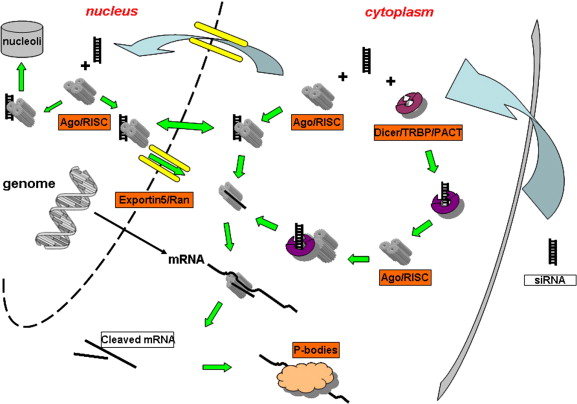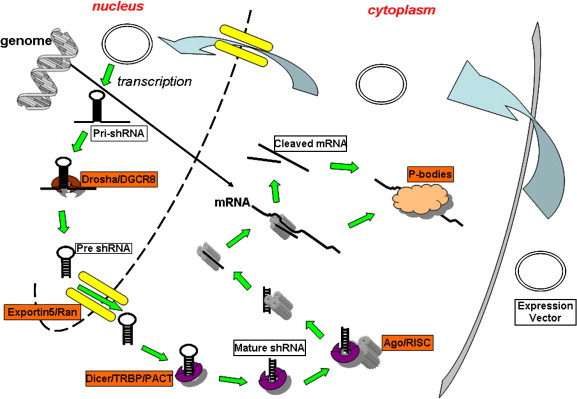siRNA is a double-stranded RNA containing 21 nucleotides (nt), with high sequence specificity. After cell transfection, siRNA can trigger rapid degradation of the corresponding mRNA in a short duration. shRNA (short hairpin RNA) is an RNA sequence of tight hairpin loop, including two short reverse repeats and a loop region connecting the two repeats. shRNA can be cloned into a plasmid vector as a "short hairpin" structure. After plasmid insertion, hairpin sequence is expressed to form double-stranded RNA (dsRNA) and enters the RNAi pathway to achieve gene silencing. The final goal of gene silencing is achieved through the RNA interference (RNAi) pathway. The expression of shRNA in cells can be achieved in vitro by transferring plasmids, viral or bacterial vectors. Among these vectors, virus-infected cells contain high efficiency in vivo, which solves the problem of low plasmid transfection efficiency for certain cell types (including primary cells and less dividing cells).


Fig.1 Differences in siRNA(left) and shRNA(right) mediated RNA interference pathways. ( Rao D, 2009)
Design and prepare 4 shRNA vectors for the target genes, ensuring that at least one shRNAs has a suppression efficiency of 70% or more at the mRNA level.
| Composition | Quantity |
| shRNA for target genes | 4 |
| positive control shRNA vector | 1 |
| negative control shRNA vector | 1 |
We can insert the DNA encoding your target shRNA into the plasmid and perform sequence correctness testing. Simply inform us the target gene sequence or Gene ID number, and name of the vector you want to insert (such as pRS, pGFP-V-RS or pRFP-C-RS) for modeling. Nevertheless, we provide enough usable, purified expression plasmids to encode your target shRNA.
After cloning siRNA fragments into target expression vectors, customers need to prepare a large number of high-purity or endotoxin-free plasmids for the next experiment. BOC Sciences offers a service for the preparation of high-purity plasmids.
Service requirements:
1) Provide plasmids to be prepared (>20 ng).
2) Plasmid resistance and macrorestriction map.
shRNA provides longer-lasting silencing effects, enables stable cell line generation, allows promoter-controlled expression, and offers cost benefits for long-term studies through vector replication.
We offer multiple vector systems including plasmid backbones with fluorescent reporters and antibiotic resistance markers, with options for viral delivery systems to suit different experimental needs.
We design and deliver four distinct shRNA vectors per target gene, ensuring at least one achieves >70% knockdown efficiency, plus appropriate positive and negative controls.
All constructs undergo sequence verification, and we provide efficiency validation data demonstrating mRNA-level knockdown performance for reliable experimental outcomes.
Yes, we offer customization of promoter elements, selection markers, and reporter genes to match specific research requirements and cell type applications.
We provide high-purity, endotoxin-free plasmid preparations suitable for sensitive cell culture applications, with comprehensive quality control including restriction mapping and concentration verification.
Reference